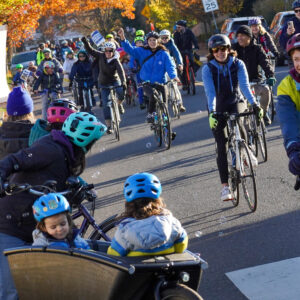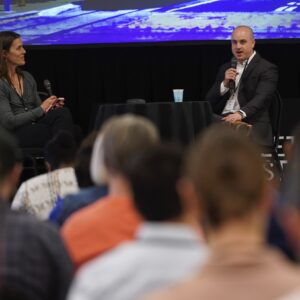Yes, it happens to kids on bikes too.
There was the usual anger and frustration when Rob Galanakis shared an incident of driver road rage with a group of bike advocates online last Wednesday. Portland bike riders have become numb to the bad behavior and disrespect shown to them by many drivers. But Rob’s story was different: He was not only raged at, but physically assaulted by a driver — and it happened as he led a weekly “bike bus” ride!
Bike buses are group bike rides to school where kids (and some parent leaders) meet at pre-determined spots and ride to school together. Rob leads the Glencoe Bike Bus, which swings by several schools in southeast Portland.
Last Wednesday Rob posted to the BikeLoud PDX Slack looking for advice. He wanted to know how best to follow up after experiencing road rage on his ride. “We had a driver tailing within a couple feet and honking… He was yelling he’s a special ed teacher and was late,” Rob wrote. “He got out of his car, grabbed my bike, threw it down, and tried to rush back into his car and drive past me.”
Rob, the kids, and a few other parents were riding north on SE 61st Avenue and were about to cross E Burnside when he first heard the honking from behind. He immediately swung into action and engaged the driver in an attempt to de-escalate the situation. Rob credits his experience doing “corking” (when riders stand in front of drivers at intersections to let large groups pass through intersections together) for giving him the training that led to a mostly positive outcome on Wednesday.
“I just cannot get over how absurd this whole situation is,” he shared in our conversation.
When asked if he’ll use this situation as a teachable moment for the kids, Rob said no. “I want to teach them to love being outside and being active and being a good citizen. And this is just teaching them to be afraid. And I don’t want to teach them to be afraid. And I do believe as long as they are smart and prepared, then they don’t need to be afraid.”
While Rob was sanguine about what happened to him, his experience at the hands of impatient/rude/dangerous river is something we hear about far too often. As bike buses have multiplied throughout Portland, a nascent advocacy coalition has formed to lobby the City of Portland for safer streets. They want more diverters to discourage cut-through traffic, more cameras to catch dangerous drivers, lower speeds on neighborhood greenways, and more.
I talked to Rob via video on Friday to learn more and I’ve shared an edited version of our conversation in the video above. In it, you’ll hear what happened and Rob’s advice for other bike bus leaders who might experience the same thing.
— You can also listen to a version of this interview on our podcast. Listen below or wherever you get your podcasts.






Thanks for reading.
BikePortland has served this community with independent community journalism since 2005. We rely on subscriptions from readers like you to survive. Your financial support is vital in keeping this valuable resource alive and well.
Please subscribe today to strengthen and expand our work.
This was really interesting, thank you!
Thanks Lisa! Glad you liked it. The publisher side of me is also really excited with how I was able to use a new bit of software to turn the video interview into a video. 😉
It is hard to know how the parents and kids are dealing with incidents like this right afterwards. It may be good to check in a week or so later to see how people feel. I have had minor road stresses when my kid was with me on the bike, and a week later, after I had nearly forgotten about it, they told me that it was making them scared and anxious to be on the bike. I am glad they said something, because I was able to reassure them. As adults, we have learned to passively accept and internalize the vast majority of trauma that happens on the roads and may not realize how intense some of these experiences are.
These events are rare and may not show up on average speed counters or other metrics used to evaluate greenways. But, they are common enough and can be devastating enough, that they need to recognized and dealt with. This is the biggest failure of the greenway system.
This is great advice, thanks SD. Thankfully the kids were far enough away when this went down, that most of them didn’t know. But I’ll make sure to check in with everyone.
As a cycling instructor and advocate for safe walking and biking, the lessons I draw from this are about how Rob G. handled this incident and the attitudes you both take during your conversation.
It’s basically calm, cool and happy in a group of people on bikes. Any displeasure or expressions from the drivers behind us can usually be ignored. We are not responsible for their feelings; we are responsible for our own safety.
It’s rare, but if a confrontation starts, hear and acknowledge the feelings and situation of the other person. Let time be your friend. If they are open to suggestions, help them find a solution to their problem.
Thank you!
Thanks for sharing this. I agree Rob gave great advice on this.
The special ed teacher needs to be identified and be fired, what a evil thing to do to those children. Adults are supposed to be the protectors of children and a special ed teacher whose job it is to help the most vulnerable students should damn well know better
At a minimum, the school leadership needs to be made aware.
You took the words right out of my mouth (keyboard?). The idea that any educator would harass and endanger a group of children is disgusting.
As a PPS special needs employee, I really hope there are professional consequences.
From what I remember from Ray Thomas’ bicyclist rights workshops, this appears to me to be an ideal case for a citizen-initiated citation – truly outrageous behavior and lots of witnesses. There should be some consequences for the driver-assaulter.
I know it’s hard to see this as a win, but I do think it’s a sign of good infrastructure. Better to have the driver stop and scream on a 25-ft street than for him to attempt to pass (especially while in a heightened emotional state), as he very well might have done if the street was a bit (or a lot) wider.
As for changing the culture, I agree with Rob. More modal filters/diverters, more infrastructure that communicates to drivers that they don’t get exclusive use of the streets. It’s a slow process, but I think the faster we improve the infrastructure, the faster that will happen.
Maybe we can repeal or rewrite ORS 814.420, 814.430, etc. to shift norms away from car privilege. Oregon’s pedestrian/intersection rules (ORS 801.220?) go a long way to knock down some of that entitlement. If the driver just had a stronger normative sense that he was wrong he would have just gone down Ankeny. Maybe a similar defusing would have occurred with that clown that dashcammed himself raging around barricades and almost mowing down Rose festival parade watchers back in October.
I agree with this to an extent. This is why, despite being the cheapest thing imaginable, something like painted sharrows have value (beyond wayfinding). They tell drivers, that officially you can expect cyclists here, in the lane, blocking your way. Obviously not everyone understands that or adheres to the norms, but it is something to say hey, I’m supposed to be here. I think it helps. In the case of this story there was nothing. No sharrows, the driver may have even been legally in the right on some level, I’m not sure.
This is also why, even though they aren’t bullet proof physical protection, painted bike lanes and plastic wands are valuable. They’re for communication, which is not nothing.
I wish there was some legislation/rules/settings etc for maps directions to avoid smaller streets. My phone is constantly telling me to cut through random neighborhoods to supposedly save time.
Agree. The last time I took a Lyft it sent the driver down a similar street (62nd from Belmont to Stark). I asked him to not take it and explained why, but I’m sure he continued on other trips and I don’t blame him. This is one of those things that seem far-fetched or unlikely until it happens due to sustained advocacy by a small group of people- maybe you’ll be the one to make it happen? (I recalled reading this: https://lamag.com/featured/waze-los-angeles-neighborhoods)
Thank PBOT’s “road diet” and “traffic calming” strategies.
Demand doesn’t disappear, it just gets diverted.
That simply isn’t true when it comes to automobiles. There are dozens of case studies for reducing total vehicle miles traveled using exactly those strategies. Look to most major cities in western Europe if you want examples. Personal automobiles are not the the only way to navigate a city, and in many cases they are the most harmful way. Demand may get diverted, but a portion of it is diverted to less societally harmful means of transportation (walking, biking, transit). It’s a math equation we all do in our heads every day about how to get from point A to point B, fiddle with the variables a little and the mode share changes. Most drivers just don’t like it when those variables change, even if the outcome is a healthier community and environment.
This is plainly untrue. I understand why it at first seems intuitive, but I’d suggest doing even cursory research into it before having an opinion.
These strategies work because 1) road diets and traffic calming often do not reduce throughput very much (they just make it more predictable and safer), 2) some demand moves to other modes as the cost of the car trip is increased, and 3) demand shifts car usage to lower-cost times. You can think of road diets like a congestion charge, but for time instead of dollars.
On top of this (which you can find corroborated in research), PBOT does extensive followup looking to see where modal filters or traffic calming pushes demand, to make sure it does not have unforeseen consequences. In fact, I think they do too much of it!
Really interesting, helpful, and enjoyable conversation. Rob has reminded me that a calm demeanor when facing a hostile driver (or fellow road user) is the best strategy. It’s far too easy to get caught up in the heated moment, so this example is very useful.